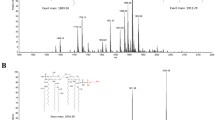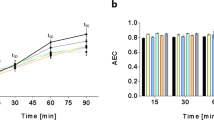Abstract
Introduction
Multivalent antimicrobial dendrimers are an exciting new system that is being developed to address the growing problem of drug resistant bacteria. Nuclear Magnetic Resonance (NMR) metabolomics is a quantitative and reproducible method for the determination of bacterial response to environmental stressors and for visualization of perturbations to biochemical pathways.
Objectives
NMR metabolomics is used to elucidate metabolite differences between wild type and antimicrobially mutated Escherichia coli (E. coli) samples.
Methods
Proton (1H) NMR hydrophilic metabolite analysis was conducted on samples of E. coli after 33 growth cycles of a minimum inhibitory challenge to E. coli by poly(amidoamine) dendrimers functionalized with mannose and with C16-DABCO quaternary ammonium endgroups and compared to the metabolic profile of wild type E. coli.
Results
The wild type and mutated E. coli samples were separated into distinct sample sets by hierarchical clustering, principal component analysis (PCA) and sparse partial least squares discriminate analysis (sPLS-DA). Metabolite components of membrane fortification and energy related pathways had a significant p value and fold change between the wild type and mutated E. coli. Amino acids commonly associated with membrane fortification from cationic antimicrobials, such as lysine, were found to have a higher concentration in the mutated E. coli than in the wild type E. coli. N-acetylglucosamine, a major component of peptidoglycan synthesis, was found to have a 25-fold higher concentration in the mid log phase of the mutated E. coli than in the mid log phase of the wild type.
Conclusion
The metabolic profile suggests that E. coli change their peptidoglycan composition in order to garner protection from the highly positively charged and multivalent C16-DABCO and mannose functionalized dendrimer.






Similar content being viewed by others
References
Addinsoft. (2019). XLSTAT 2019: Data analysis and statistical solution for microsoft excel. Paris: France.
Alanis, A. J. (2005). Review article: Resistance to antibiotics: Are we in the post-antibiotic era? Archives of Medical Research, 36, 697–705.
Ammons, M. C. B., Tripet, B. P., Carlson, R. P., Kirker, K. R., Gross, M. A., Stanisich, J. J., et al. (2014). Quantitative NMR metabolite profiling of methicillin-resistant and methicillin-susceptible staphylococcus aureus discriminates between biofilm and planktonic phenotypes. Journal of Proteome Research, 13, 2973–2985.
Ammons, M. C. B., Morrissey, K., Tripet, B. P., Van Leuven, J. T., Han, A., Lazarus, G. S., et al. (2015). Biochemical association of metabolic profile and microbiome in chronic pressure ulcer wounds. PLoS ONE, 10(5), 1–22. https://doi.org/10.1371/journal.pone.0126735.
Anderson, R. J., Groundwater, P. W., Todd, A., & Worsley, A. J. (2012a). Microorganisms. Antibacterial Agents: Chemistry, Mode of Action, Mechanisms of Resistance and Clinical Applications (pp. 3–32). West Sussex, UK: Wiley.
Anderson, R. J., Groundwater, P. W., Todd, A., & Worsley, A. J. (2012b). Glycopeptide Antibiotics. Antibacterial Agents: Chemistry, Mode of Action, Mechanisms of Resistance and Clinical Applications (pp. 305–318). West Sussex, UK: Wiley.
Andre, S., Pieters, R. J., Vrsaidas, I., Kaltner, H., Kuwabara, I., Liu, F.-T., et al. (2001). Wedgelike glycodendrimers as inhibitors of binding of mammalian galectins to glycoproteins, lactose maxiclusters, and cell surface glyconjugates. ChemBioChem, 2, 822–830.
Barding, G. A., Salditos, R., & Larive, C. K. (2012). Quantitative NMR for bioanalysis and metabolomics. Analytical and Bioanalytical Chemistry, 404, 1165–1179.
Chabre, Y., & Roy, R. (2008). Recent trends in glycodendrimer syntheses and applications. Current Topics in Medicinal Chemistry, 8(14), 1237–1285.
Chen, C. Z., Beck-Tan, N. C., Dhurjati, P., Van Dyk, T. K., LaRossa, R. A., & Cooper, S. L. (2000). Quaternary ammonium functionalized poly(propylene imine) dendrimers as effective antimicrobials: structure-activity studies. Biomacromolecules, 1, 473–480.
Chenomx (2016) N.M.R. Suite 8.2. Edmonton: Chenomx Inc.
Chong, J., Wishart, D. S., & Xia, J. (2019). Using metaboanalyst 4.0 for comprehensive and integrative metabolomics data analysis. Current Protocols in Bioinformatics, 68, e86.
Cloninger, M. J. (2002). Biological applications of dendrimers. Current Opinions in Chemical Biology, 6, 742–748.
Denamur, E., & Matic, I. (2006). Evolution of mutation rates in bacteria. Molecular Microbiology, 60(4), 820–827.
Dettmer, K., Aronov, P. A., & Hammock, B. D. (2007). Mass spectrometry-based metabolomics. Mass Spectrometry Review, 26, 51–78.
Engel, R., Ghani, I., Montenegro, D., Thomas, M., Klaritch-Vrana, B., Castaño, A., et al. (2011). Polycationic glycosides. Molecules, 16, 1508–1518.
García-Gallego, S., Franci, G., Falanga, A., Gómez, R., Folliero, V., Galdiero, S., et al. (2017). Function oriented molecular design: Dendrimers as novel antimicrobials. Molecules, 22, 1581–1610.
Gonzáles-Bello, C. (2017). Antibiotic adjuvants- a strategy to unlock bacterial resistance to antibiotics. Bioorganic and Medicinal Chemistry Letters, 27, 4221–4228.
Hammes, W., Schleifer, K. H., & Kandler, O. (1973). Mode of action of glycine on the biosynthesis of peptidoglycan. Journal of Bacteriology, 116(2), 1029–1053.
Hoerr, V., Duggan, G. E., Zbytnuik, L., Poon, K. K. H., Große, C., Neugebauer, U., et al. (2016). Characterization and prediction of the mechanism of action of antibiotics through NMR metabolomics. BMC Microbiology, 16(82), 1–14. https://doi.org/10.1186/s12866-016-0696-5.
Humann, J., & Lenz, L. L. (2009). Bacterial peptidoglycan degrading enzymes and their impact on host muropeptide detection. Journal of Innate Immunity, 1, 88–97.
Jiao, Y., Niu, L-n, Ma, S., Li, J., Tay, F. R., & Chen, J-h. (2017). Quaternary ammonium-based biomedical materials: State-of-the-Art, toxicological aspects and antimicrobial resistance. Progress in Polymer Science, 71, 53–90.
Kanehisa, M., & Goto, S. (2000). KEGG: Kyoto encyclopedia of genes and genomes. Nucleic Acid Research, 28, 27–30.
Lämmerhofer, M., Weckwerth, W., Eds, (2013) NMR-Based Metabolomic Analysis: In Metabolomics in Practice: Successful Strategies to Generate and Analyze Metabolic Data. (pp. 209–233). Weinheim, Germany: Wiley-VCH.
Lindon, J. C., Nicholson, J. K., & Holmes, E. (2007). NMR Spectroscopic Techniques for Application to Metabonomics: In the Handbook of Metabolomics and Metabonomics (pp. 55–112). Oxford, UK: Elsevier.
Loskill, et al. (2014). Reduction of the peptidoglycan crosslinking causes a decrease in the stiffness of the Staphylococcus aures cell envelope. Biophysical Journal, 107, 1082–1089.
Lu, W., & Pieters, R. J. (2019). Carbohydrate-protein interactions and multivalency: Implications for the inhibition of influenza A virus infections. Expert Opinion on Drug Discovery, 14(4), 387–395.
Martinez, J. L., & Baquero, F. (2000). Minireveiw: Mutation frequency and antibiotic resistance. Antimicrobial Agents and Chemotherapy, 44(7), 1771–1777.
McDonnell, G., & Russell, A. D. (1999). Antiseptics and disinfectants: Activity action and resistance. Clinical Microbiology Review, 12(1), 147–226.
Mengin-Lecreulx, D., Blanot, D., & VanHeijenoort, J. (1994). Replacement of diaminopimelic acid by cystathionine or lanthionine in the peptidoglycan of Escherichia coli. Journal of Bacteriology, 176(14), 434–437.
Mintzer, M. A., Dane, E. L., O’Toole, G. A., & Grinstaff, M. W. (2011). Exploiting dendrimer multivalency to combat emerging and reemerging infectious diseases. Molecular Pharmaceutics, 9, 342–354.
Paleos, C. M., Tsiourvas, D., Sideratou, Z., & Tziveleka, L.-A. (2010). Drug delivery using multifunctional dendrimers and hyperbranched polymers. Expert Opinion on Drug Delivery, 7, 1387–1398.
Perlin, M. H., Clark, D. R., McKenzie, C., Patel, H., Jackson, N., Kormanik, C., et al. (2009). Protection of salmonella by ampicillin-resistant escherichia coli in the presence of otherwise lethal drug concentrations. Proceedings of the Royal Society B, 276, 3759–3768.
Pokhrel, S., Nagaraja, K. S., & Varghese, B. (2004). Preparation, characterization and X-ray structure analysis of 1,4-diazabicyclo-2,2,2-octane (DABCO) and ammonium cation with tetrathiomolybdate anion. Journal of Structural Chemistry, 45(5), 900–905.
Roy, R. (2003). A decade of glycodendrimer chemistry. Trends in Glycoscience and Glycotechnology, 15(85), 291–310.
Shepard, J., & Ibba, M. (2013). Direction of aminoacylated transfer RNAs into antibiotic synthesis and peptidoglycan-mediated antibiotic resistance. FEBS Letters, 587(18), 2895–2904.
Shulaev, V. (2006). Metabolomics technology and bioinformatics. Briefings in Bioinformatics, 7(2), 128–139.
Soini, J., Ukkonen, K., & Neubauer, P. (2008). High cell density media for Escherichia coli are generally designed for aerobic cultivations – consequences for large-scale bioprocesses and shake flask cultures. Microbial Cell Factors, 7, 26–36.
Sreeperumbuduru, R. S., Abid, Z. M., Claunch, K. M., Chen, H. H., McGillivray, S. M., & Simanek, E. E. (2016). Synthesis and antimicrobial activity of triazine dendrimers with DABCO groups. Royal Society of Chemistry Advances, 6, 8806–8810.
Todar, K., (2012). Textbook of bacteriology (Online). University of Wisconsin, https://textbookofbacteriology.net. Accessed 9 April 2015.
VanKoten, H. W., Dlakic, W. M., Engel, R., & Cloninger, M. J. (2016). Synthesis and biological activity of highly cationic dendrimer antibiotics. Molecular Pharmaceutics, 13, 3827–3834.
Vembu, S., Pazhamalai, S., & Gopalakrishnan, M. (2015). Potential antibacterial activity of triazine dendrimer: synthesis and controllable drug release properties. Bioorganic and Medicinal Chemistry, 23, 4561–4566.
Wolfenden, M., Cousin, J., Nangia-Makker, P., Raz, A., & Cloninger, M. (2015). Glycodendrimers and modified ELISAs: Tools to elucidate multivalent interactions of galectins 1 and 3. Molecules, 20, 7059–7096.
Wrońska, N., Majoral, J. P., Appelhans, D., Bryszewska, M., & Lisowska, K. (2019). Synergistic effects of anionic/cationic dendrimers and levofloxacin on antibacterial activities. Molecules, 24, 2894–2905.
Xue, X., Chen, X., Mao, X., Hou, Z., Zhou, Y., Bai, H., et al. (2013). Amino-terminated generation 2 Poly(amidoamine) dendrimer as a potential broad-spectrum, nonresistance-inducing antibacterial agent. AAPS Journal, 15, 132–142.
Acknowledgements
Funding from NIGMS 62,444 is gratefully acknowledged. Dr. Harrison VanKoten provided the bacterial stocks. Dr. Brian Tripet and Dr. Mary Cloud Ammons helped to develop the procedures for metabolite extraction and analysis, and Dr. Brian Tripet helped with acquisition of NMR spectra.
Author information
Authors and Affiliations
Contributions
MLA grew and collected bacterial culture samples, extracted the metabolites, prepared the samples for NMR spectral acquisition, processed the NMR data, performed data analysis and interpretation, and wrote the manuscript. MJC oversaw all aspects of the research project and co-wrote the manuscript.
Corresponding author
Ethics declarations
Conflict of interest
Both authors declare that they have no conflicts of interest.
Research involving human and/or animal participants
This article does not contain any studies with human and/or animal participants performed by either of the authors.
Additional information
Publisher's Note
Springer Nature remains neutral with regard to jurisdictional claims in published maps and institutional affiliations.
Electronic supplementary material
Below is the link to the electronic supplementary material.
Rights and permissions
About this article
Cite this article
Aries, M.L., Cloninger, M.J. NMR metabolomic analysis of bacterial resistance pathways using multivalent quaternary ammonium functionalized macromolecules. Metabolomics 16, 82 (2020). https://doi.org/10.1007/s11306-020-01702-1
Received:
Accepted:
Published:
DOI: https://doi.org/10.1007/s11306-020-01702-1




